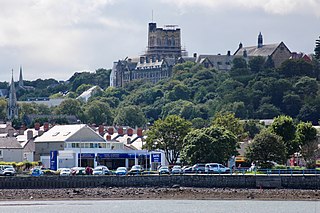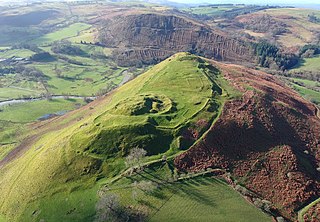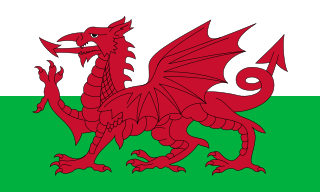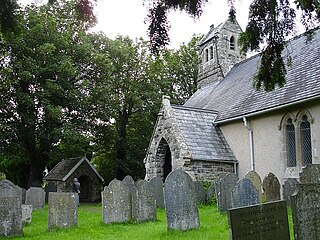Related Research Articles

Glamorgan, or sometimes Glamorganshire, was one of the thirteen historic counties of Wales in the south of Wales. Originally an early medieval petty kingdom of varying boundaries known in Welsh as Morgannwg, which was then invaded and taken over by the Normans as the Lordship of Glamorgan. The area that became known as Glamorgan was both a rural, pastoral area, and a conflict point between the Norman lords and the Welsh princes. It was defined by a large concentration of castles.

Trellech is a village and parish in Monmouthshire, south-east Wales. Located 5 miles (8 km) south of Monmouth and 4 miles (6.4 km) north-north-west of Tintern, Trellech lies on a plateau above the Wye Valley on the southern fringes of 320 acres (130 ha) of woodland in an Area of Outstanding Natural Beauty. Three Bronze Age standing stones are situated in the village, known as Harold's Stones, which overlook the historic church of St Nicholas, a Grade I listed building.

Carmarthen is the county town of Carmarthenshire and a community in Wales, lying on the River Towy 8 miles (13 km) north of its estuary in Carmarthen Bay. At the 2021 census the community had a population of 14,636, and the built up area had a population of 16,455. It stands on the site of a Roman town, and has a claim to be the oldest town in Wales. In the middle ages it comprised twin settlements: Old Carmarthen around Carmarthen Priory and New Carmarthen around Carmarthen Castle. The two were merged into one borough in 1546. It was the most populous borough in Wales in the 16th–18th centuries, described by William Camden as "chief citie of the country". It was overtaken in size by the mid-19th century, following the growth of settlements in the South Wales Coalfield.

Bangor is a cathedral city and community in Gwynedd, North Wales. It is the oldest town in Wales. Historically part of Caernarfonshire, the community had a population of 15,060 at the 2021 census, and the built up area had a population of 16,990. Landmarks include Bangor Cathedral, Bangor University and Garth Pier. The Britannia and Menai Suspension bridges connect the city to the Isle of Anglesey.

Cunedda ap Edern, also called Cunedda Wledig, was an important early Welsh leader, and the progenitor of the Royal dynasty of Gwynedd, one of the very oldest of Western Europe.

Cyfraith Hywel, also known as Welsh law, was the system of law practised in medieval Wales before its final conquest by England. Subsequently, the Welsh law's criminal codes were superseded by the Statute of Rhuddlan in AD 1284 and its civil codes by Henry VIII's series of Laws in Wales Acts between 1535 and 1542.

Cefnllys Castle was a medieval spur castle in Radnorshire, Wales. Two successive masonry castles were built on a ridge above the River Ithon known as Castle Bank in the thirteenth century, replacing a wooden motte-and-bailey castle constructed by the Normans nearby. Controlling several communication routes into the highlands of Mid Wales, the castles were strategically important within the Welsh Marches during the High Middle Ages. As the seat of the fiercely contested lordship and cantref of Maelienydd, Cefnllys became a source of friction between Llywelyn ap Gruffudd and Roger Mortimer in the prelude to Edward I's conquest of Wales (1277–1283). Cefnllys was also the site of a borough and medieval town.

Bleddyn ap Cynfyn, sometimes spelled Blethyn, was an 11th-century Welsh king. King Harold Godwinson and Tostig Godwinson installed Bleddyn and his brother, Rhiwallon, as the co-rulers of kingdom of Gwynedd on his father's death in 1063, during their destruction of the kingdom of their half-brother, king Gruffydd ap Llywelyn. Bleddyn became king of Powys and co-ruler of the Kingdom of Gwynedd with his brother Rhiwallon from 1063 to 1075. His descendants continued to rule Powys as the House of Mathrafal.

The House of Gwynedd was a royal house during medieval Wales. The dynasty is seen as being divided between the founding of the kings settlement in Gwynedd during the Roman invasion of Britain and the subsequent kingdoms in Wales until after the Norman invasion of Wales and the subsequent incorporation of the separate kingdoms into the Principality of Wales.

Arfon was a mediaeval Welsh cantref in north-west Wales. It was the core of the kingdom of Gwynedd. Later it was included in the new county of Caernarfonshire, together with Llŷn and Arllechwedd under the terms of the Statute of Rhuddlan in 1284. The island of Anglesey faced it across the Menai Strait; to the east was the cantref of Arllechwedd, to the south the cantref of Eifionydd, and to the west was the cantref of Llŷn.

Wales in the early Middle Ages covers the time between the Roman departure from Wales c. 383 until the middle of the 11th century. In that time there was a gradual consolidation of power into increasingly hierarchical kingdoms. The end of the early Middle Ages was the time that the Welsh language transitioned from the Primitive Welsh spoken throughout the era into Old Welsh, and the time when the modern England–Wales border would take its near-final form, a line broadly followed by Offa's Dyke, a late eighth-century earthwork. Successful unification into something recognisable as a Welsh state would come in the next era under the descendants of Merfyn Frych.
St Ishmaels or St Ishmael's is a village, parish and community close to the Milford Haven Waterway in Pembrokeshire, Wales.

Various traditions are practiced on certain days of the year in Wales both currently and historically, including festivities originating in Welsh, Celtic, English and Christian cultures.

Llanfaes is a small village on the island of Anglesey, Wales, located on the shore of the eastern entrance to the Menai Strait, the tidal waterway separating Anglesey from the north Wales coast. Its natural harbour made it an important medieval port and it was briefly the capital of the kingdom of Gwynedd. Following Prince Madoc's Rebellion, Edward I removed the Welsh population from the town and rebuilt the port a mile to the south at Beaumaris. It is in the community of Beaumaris.
Arthur Wade Wade-Evans was a Welsh clergyman and historian.

Parc Cwm long cairn, also known as Parc le Breos burial chamber, is a partly restored Neolithic chambered tomb, identified in 1937 as a Severn-Cotswold type of chambered long barrow. The cromlech, a megalithic burial chamber, was built around 5,850 years before present (BP), during the early Neolithic. It is about seven 1⁄2 miles (12 km) west south–west of Swansea, Wales, in what is now known as Coed y Parc Cwm at Parc le Breos, on the Gower Peninsula.

Llangadfan is a small village in Powys, Wales, based in the community of Banwy. The village lies on the A458 between Foel and Llanerfyl, 12 kilometres (7.5 mi) from Llanwddyn. Dyfnant Forest is located nearby. The village is said to be known for its country dances.
The ceiniog was the basic currency of the medieval Welsh kingdoms such as Gwynedd and Deheubarth. Hywel Dda was the only ruler recorded as minting his own proper coins; however, the ceiniog was not a coin but a value of silver. The "legal penny" was the weight of 32 wheat grains in silver; the "curt penny", the weight of 24 wheat grains. The latter was based on the old Roman pound; the former, Charlemagne's and Offa's. The Welsh half-penny was the dymey of 12 wheat grains and the farthing (quarter-penny) was the firdlyc of 6.
Welsh units of measurement are those in use in Wales between the Sub-Roman period and the 13th-century Edwardian conquest. Modern Wales no longer employs these units even for customary purposes but instead follows the custom as elsewhere in Britain of using a mixture of metric and Imperial units.
A taeog was a native serf or villein of the medieval Welsh kingdoms. The term was used in south Wales and literally denoted someone "belonging to the house" (ty) of the lord's manor. The equivalent term in north Wales was aillt or mab aillt.
References
- ↑ Jones, R.A. (1998). "Problems with medieval Welsh local administration—the case of the maenor and the maenol". Journal of Historical Geography . 24 (2): 135–146. doi:10.1006/jhge.1998.0082.
- 1 2 3 Wade-Evans, Arthur. Welsh Medieval Law . Oxford Univ., 1909. Accessed 1 Feb 2013.
- ↑ Wade-Evans. p. 348.
- ↑ Wade-Evans. p. 349.